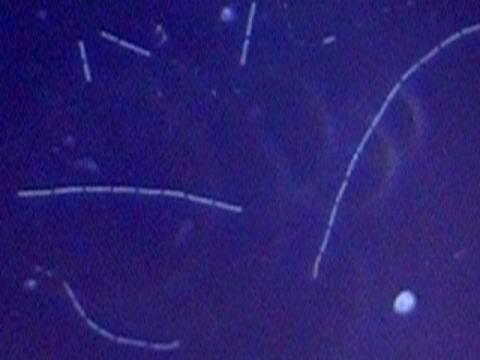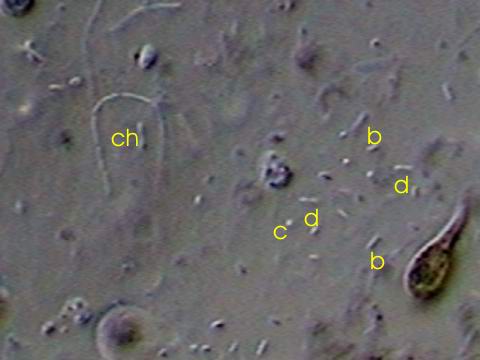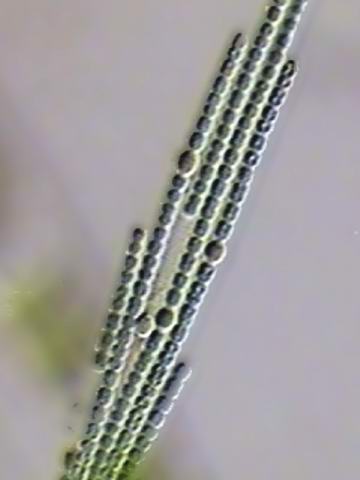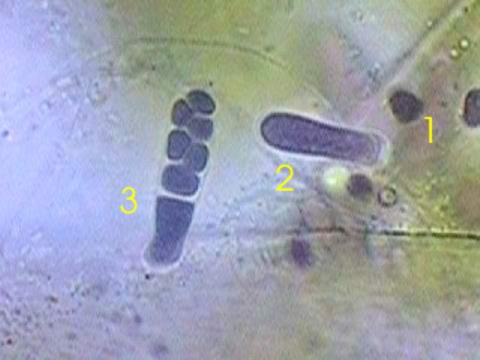'A FIELD GUIDE TO BACTERIA'
An exciting
book for the amateur microscopist. Reviewed for Micscape
Magazine by Walter Dioni.
Updated July 2014
Please note: If you wish to purchase this book, the Cornell Links do not work.
You can:
Purchase from Amazon UK Here!
Purchase from Amazon USA Here!
|
|
A FIELD GUIDE TO BACTERIA by Betsey Dexter Dyer ISBN 0-8014-3902-7 (cloth)
US $49-95 Cornell University Press - Ithaca (USA) and London (UK).
|
People hear of bacteria almost everyday of their lives; most of the time they are linked to diseases or to trivial products such as yoghurt or similar. As the author states, more than 2000 species of bacteria, divided between 300 to 500 genera according to different bacteriologists, are named today and described with precision.
But the notion that we are immersed in a soup of millions and millions of bacteria is out of our minds.
Betsey Dexter Dyer takes on the task of making us conscious of the role that these microscopic organisms play in our daily life. I think that there is no better way to understand her goals than to transcribe a paragraph from the Introduction of the book:
“I learned that many bacteria can be identified by macroscopic field marks.....Although most people are aware that bacteria are all around us, few would guess that they produce such distinctive and accessible signs. Whether you’re walking on the beach, visiting a zoo or aquarium, buying groceries, looking for fossils, drinking beer, traipsing through a swamp or cleaning scum from a dripping outdoor faucet, you are surrounded by bacterial field marks. You don’t need a laboratory or fancy equipment to find out what kind of bacteria are there—this guide will tell you how.”
The author has honored her purpose and the book is, from a non-microbiologist's point of view, a fascinating one.
First of all, the new role that bacteria play in modern science is disclosed. The pioneering work that was undertaken on the bacteria at thermal habitats of the Yellowstone Park, in the USA, (now better known as archaea) were the starting point of a real revolution in the understanding of the taxonomy and relationships of microorganisms, their ultra-structure and from the 1980’s onwards, the composition of their DNA which allows us to better understand their phylogeny.
Many of the traits of the still shifting revolution are summarized in this quote from page 7 of the book:
“As more and more bacterial genes were sequenced during the 1980s and 1990s, there came some big surprises. First the bacteria or prokaryotes, could be divided into two large, very different groups, now named the archaea (or archaebacteria) and the bacteria (or eubacteria)…Second, metabolism, once trusted indicator of bacterial phylogeny, was found to be an unreliable trait for most groups of bacteria. Most of the bacterial groups presented a seeming jumble of metabolic diversity. Third, some groups once considered “primitives” now become positioned on advanced branches, and vice versa. The new bacterial phylogeny that emerged was at first a challenge to explain and defend. However, this new phylogeny also produced new ways of understanding bacterial evolution.”
As never
before, the procaryota were assigned
a very important position in the phylogenetic tree. Their role in the
development of the eukaryotic cell
was acknowledged, and this crucial instance marked really the birth of the new
bacteriology.
The author emphasizes this point of view by adopting a taxonomic layout for her book.
|
|
|
Bacilli
chains
in a water film of an aquarium. Central darkfield
stop. This and the rest of the pictures included here were originally taken
at x1000. Cropped and adjusted to a picture width that covers 66.7 µm.
Image by the reviewer Walter Dioni. |
Leaving apart the Introduction and the Guide to habitats which make up 33 pages, the rest is an 18 chapter (266 pgs) compendium of most of the large groups of bacteria (excluding most of the pathogenic ones) the author recognizes in the included phylogenetic tree. Thirty figures in the text and ninety-eight color pictures (called plates in the book and arranged in a block of 15 pages in the center of the book) demonstrate the morphology, habitat or field marks ("macroscopic traits that permits us to ascertain the presence and, or, the action") of a group of procaryota that the author describes in the text.
Each chapter is divided into sections which describes in a mostly non-technical and clear terminology, the morphological, biochemical, and ecological traits of the discussed group of bacteria, which make up for the bulk of the text. Each section includes a guide to recognize a group's macroscopic field marks (color, growth form, smell, flavor and so on, even sounds), and some advice on viewing bacteria through the microscope and on culturing some species. In every Chapter a concise Summary displays the most important traits of the procaryota group which have been discussed.
|
|
|
Surface
film from a small puddle. ch- bacilli chains, b-
bacilli,
c- coccus, d- diplococcus. There are also some yeasts,
and an algae propagulus. Marginal oblique illumination.
Image by the reviewer Walter Dioni. |
The chapters'
structure is clearly displayed and this allows the consultation in the field or
the lab very easily.
Here is an abridged List of the Table of Contents
Introduction: Becoming Bacteriocentric**
Guide to habitats
Chapter 1: Ancient
Hypertermophiles and Thermophilic Green Nonsulfurs
Chapter 2: Methanogens
Chapter 3: Hypertermophilic Archaea
Chapter 4: Halophiles
Chapter 5: Green Sulfur Bacteria
Chapter 6: Alpha Proteobacteria
Chapter 7: Beta Proteobacteria
Chapter 8: Gamma and Delta Proteobacteria of Non-Sulfur-Rich Environments
Chapter 9: Gamma and Delta Proteobacteria of Sulfur-Rich Environments
Chapter 10: Gram-positive Bacteria of Foods and Drinks
Chapter 11: Gram positive Bacteria of Soils and Other Substrates
Chapter 12: Gram-positive Bacteria as Symbionts of Animals and Plants
Chapter 13: Cyanobacteria of Aquatic and Terrestrial Habitats
Chapter 14: Cyanobacterial Associations with Other Organisms
Chapter 15: Bacteroides, Gliders, and Their Relatives
Chapter 16: Spirochetes
Chapter 17: Thermus and Deinococcus
Chapter 18: Planctomycetes and Their Relatives
Appendix A: How to Culture Bacteria
Appendix B: How to use a Microscope
Appendix D: Suggestions for Science Fair and Classroom Projects
Appendix E: Life List of Bacteria
Glossary
References
Index
|
|
|
A cyanobacteria (Anabaena) from a freshwater sample. Bright field.
Image by the reviewer Walter Dioni. |
It is possible, of course, that the amateur microscopist may find the suggestions in the chapters or in the Appendix C not detailed enough, but they are an aid to the observation of live bacteria, and not for the lab preparation of slides. So, leaving apart the chapter on the distinction between Gram-positive and Gram-negative bacteria, no mention is generally given on staining techniques or for the preparation of permanent slides.
A similar criterion (to reach the non-technical people with little equipment) is applied to the culturing of the organisms. So, many of the chapters do not give culture suggestions, but instead warn about the difficulties involved or the dangers implied.
Nonetheless an Appendix A describes in a detailed form the methods that an amateur can use to make pure cultures on broth or solid media, using no more than kitchen equipment (with a warning not to use the kitchenware of mom or wife of course, but rather an especially dedicated set).
But there are many chapters, especially about the Gram-positive bacteria, and the cyanobacteria, which can supply enough material to keep an interested microscopist busy for days and days.
|
|
|
An
epiphytic cyanobacteria of the order Chamasiphonacea. The numbers
identify thre growth steps. Brightfield, live material. A gelatinous
envelope is discernable. The color is imparted by the phycocianin. Image by
the reviewer Walter Dioni. |
And after reading the book I think that most of the readers equipped with a microscope and some micro-pipettes for sampling, will wish to establish several Winogradsky columns, with many distinct materials from different sources, to try to ascertain the populations developed at different levels in the column.
Contrary to the pure culture medium, the Winogradsky column (illustrated in the cover picture), can be established in any tall cylindrical container, and gives a mixed style of culture that allows the ecological preferences of the bacteria to be displayed in a layered series of cultures, with anaerobic forms iat the bottom and the aerobic ones at the free surface.
As she stated in the book, the author has had one of these decorating her windowsill, for more than 20 years.
It is very difficult, and certainly it is the best credit to the author, to cover such a wide field of knowledge, which certainly merits to be developed as an encyclopedia, in such a condensed book. In many chapters the author is consciously unable to fulfill all goals, especially on the culture methods and sends the reader to auxiliary bibliography. This is a very legitimate technique given the fact that the reader is not supposed to have a microbiological laboratory, For example, to culture the bacteria responsible for the production of pickled foods they would need to make pickles, and certainly adequate techniques are described exhaustively in many others books on dietetics.
It is a pity, from our amateur microscopists' point of view, that the most significant chapters of the book must deal with the thermophilic bacteria, i.e. those that prompted the “revolution” in bacteriology and phylogeny. They are secluded in very special habitats that even those who live near such habitats cannot explore freely in view of the fragility of the ecosystems involved and the laws for their conservation. The Yellowstone Park is the paradigm. For those of us that live where the sulfurous and very hot (e.g. 80şC) thermal waters are out of reach, these chapters can only whet our appetite.
But they enlighten the non-professional biologist about the more significant developments of the last 25 years on the basis of the modern concepts on the evolution of the living world.
It is difficult to leave the book once we start reading it. And it would certainly not be confined to the bookshelves but would be a companion on the working table at our lab, or in the haversack when we walk abroad.
But I think that almost all of us would be strongly motivated to explore our samples through the microscope with a new feeling and interest in the tiny specks and rods that normally we skip over, that are omnipresent in the earth, the water or even the air, and in all the stuff that surrounds us in the house, the streets or the fields (and even on and inside us).
So be prepared with your high power objectives (x40, x60, x100), and your collection of darkfield and oblique light stops. They must be put to work to allow you to explore the morphological diversity of free-living prokaryotes.
I’ll be confident that most of those that make a trial study of bacteria would become bacteriophilic.
The References include 52 titles of articles and books that can satisfy the further enquiries of a newcomer to the bacteria world prompted by reading this very interesting book. The older references include the magnificent little book of Paul de Kruif (1927) “The microbe hunters” that must be certainly as inspiring now as it was for young biologists throughout the Twentieth Century.
|
Note: For those interested in the Winogradsky technique, (probably the most useful method of bacterial culture within reach of the amateur not expert in bacteriology) there is an interesting article in Micscape by Gordon Couger: August 2002 - Habitat for Lab Specimens and other uses for Common Household Items In which is included the description of a plate technique to apply the Winogradsky method that allows a controlled way to sample the different levels of the sediments column, and even apply different nutrients (or even toxics) to selected populations.The article also has a good bibliography that could help the interested amateur microscopist inspired by the book to better explore the bacterial world with the Winogradsky method. |
Walter Dioni is a retired professional biologist living in Mexico.
Acknowledgement: The Micscape Editor and the reviewer would like to thank Cornell University Press for the review copy of the book, for permission to use the front cover image and to quote from the book.
Links:
Cornell
University Press web site.
Cornell University Press web
page describing
the book 'A
field guide to bacteria' with facilities for online ordering.
Microscopy
UK Front Page
Micscape
Magazine
Article
Library
© Microscopy UK or their contributors.
Published in the January 2004 edition of Micscape.Please report any Web problems or offer general comments to the Micscape Editor.
Micscape is the on-line monthly magazine of the Microscopy
UK web
site at Microscopy-UK
© Onview.net Ltd, Microscopy-UK, and all contributors 1995 onwards. All rights reserved. Main site is at www.microscopy-uk.org.uk with full mirror at www.microscopy-uk.net.




